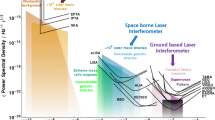Summary
The analysis of the sensitivity of a gravitational-wave antenna system shows that the role of the algorithms used for the analysis of the experimental data is comparable to that of the experimental apparatus. After a discussion of the processing performed on the input signals by the antenna and the electronic instrumentation, we derive a mathematical model of the system. This model is then used as a basis for the discussion of a number of data analysis algorithms that include also the Wiener-Kolmogoroff optimum filter; the performances of the algorithms are presented in terms of signal-to-noise ratio and sensitivity to short bursts of resonant gravitational waves. The theoretical results are in good agreement with the experimental results obtained with a small cryogenic antenna (24 kg).
Riassunto
L'analisi della sensibilità di un'antenna gravitazionale mostra che il ruolo degli algoritmi usati per l'analisi dei dati sperimentali è confrontabile con quello dell'apparato sperimentale. Dopo una discussione dell'elaborazione compiuta sui segnali d'ingresso dall'antenna e dalla strumentazione electtronica si ricava un modello matematico del sistema. Questo modello è quindi usato come base per la discussione di alcuni algoritmi di analisi dei dati, che comprendono anche il filtro ottimo di Wiener-Kolmogoroff; le prestazioni degli algoritmi sono presentate in termini di rapporto segnale-rumore e di sensibilità a brevi pacchetti di onde gravitazionali risonanti. I risultati teorici sono in buon accordo con i risultati sperimentali ottenuti con una piccola antenna criogenica (24 kg).
Резюме
Анализ чувствительности системы антенн гравитационных воли показывает, что роль алгоритмов, использованных для анализа экспериментальных данных, соизмерима с ролью экспериментальной аппаратуры. После сбсуждения процесса обработки входных сигналов, мы предлагаем математическую модель системы. Эта модель используется для обсуждения различных алгоритмсв анализа данных, которые включают оптимальный фильтр Винера-Колмогорова. Характеристики алгоритмов выражаются через отнощение сигнала к шуму и чувствительность к коротким импульсам резонансных гравитационных волн. Теоретические результаты согласуются с экспериментальными результатами, полугенными с помощью малой криогенной антенны (24 кг).
Similar content being viewed by others
References
J. Weber:Theory of the gravitational radiation detector with ferroelectric crystal coupling, inExperimental Gravitation, edited byB. Bertotti (New York, N. Y., 1974).
G. V. Pallottino andG. Pizzella:Nuovo Cimento,45 B, 275 (1978).
A. Papoulis:Probability, Random Variables and Stochastic Processes (New York, N. Y., 1965).
T. Kailath:Proc. IEEE,58, 680 (1970).
E. Amaldi, P. Bonifazi, F. Bordoni, C. Cosmelli, V. Ferrari, U. Giovanardi, I. Modena, G. V. Pallottino, G. Pizzella andG. Vannaroni:Nuovo Cimento,1 C, 341 (1978).
P. Bonifazi, V. Ferrari, S. Frasca andG. V. Pallottino:Discrete time algorithms for gravitational-wave experiment data analysis, in preparation.
Author information
Authors and Affiliations
Rights and permissions
About this article
Cite this article
Bonifazi, P., Ferrari, V., Frasca, S. et al. Data analysis algorithms for gravitational-wave experiments. Il Nuovo Cimento C 1, 465–487 (1978). https://doi.org/10.1007/BF02510106
Received:
Published:
Issue Date:
DOI: https://doi.org/10.1007/BF02510106




